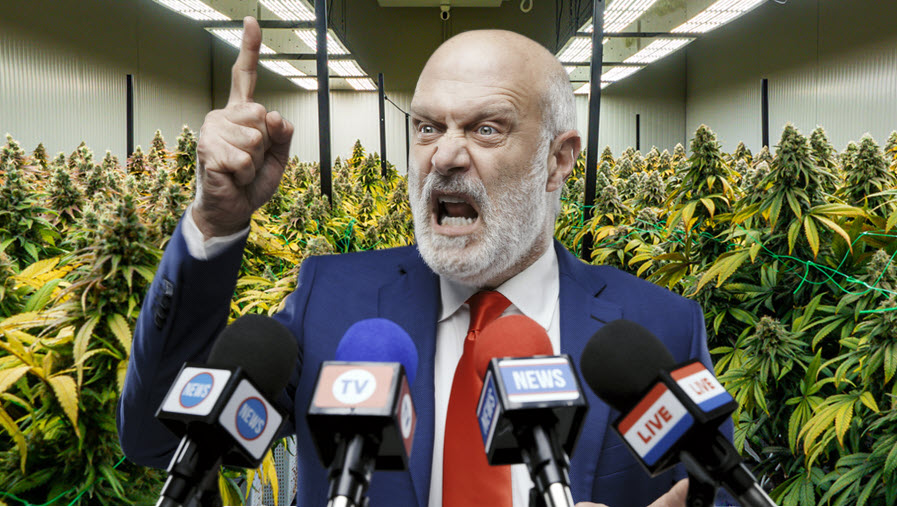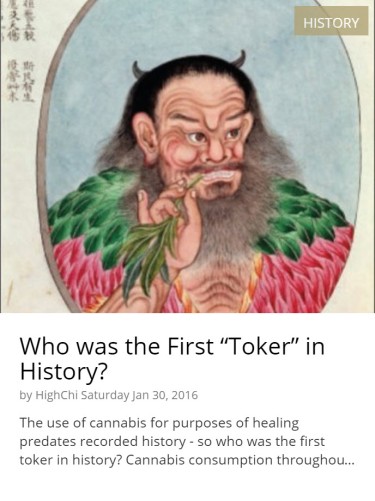Cannabis News
The 10 Most Significant Dates in Cannabis History (2024 Update)
Published
1 year agoon
By
admin

Most people don’t understand the history of cannabis, and I don’t blame them. The truth of the matter is that cannabis history is quite significant dating back thousands of years. Some people even believe that cannabis might have been one of the first crops we have ever harvested as modern humans. Seems that cannabis has coevolved with humanity for thousands of years, and This is why it is quite difficult to pinpoint exactly what happened with cannabis throughout history.
However, over the past 100 years, we have a lot more accurate records about what had happened especially with the government, legality, social attitudes, and more.
This is why I have decided to work on this piece today, to provide some historical context of cannabis over the years. What follows is what I found to be some of the more significant dates of modern cannabis history, designed to educate the modern consumer on how we got where we are today.
It’s important to create accurate records of what happened in the past – otherwise we might find ourselves in the same position of prohibition in a hundred or two hundred years.
While I know that this digital record is “soft” – in that it can easily be destroyed. My hope is to inscribe some of these important dates into your consciousness, so that the data remains.
1925: The US Congress passes the Marihuana Tax Act, effectively prohibiting cannabis at the federal level.
The Marihuana Tax Act of 1925 was a federal law in the United States that effectively prohibited the use, possession, and sale of cannabis. It was passed by Congress on December 18, 1925, and signed into law by President Calvin Coolidge on January 6, 1926.
The act was largely the work of Harry Anslinger, the commissioner of the Federal Bureau of Narcotics. Anslinger was a staunch prohibitionist who was determined to ban all drugs, including cannabis. He lobbied Congress for years to pass a cannabis prohibition law, and he was finally successful in 1925.
The Marihuana Tax Act imposed a high tax on the sale and possession of cannabis. The tax was so high that it was essentially prohibitive. The act also required anyone who sold or possessed cannabis to register with the federal government and pay an annual tax.
The stated purpose of the Marihuana Tax Act was to generate revenue for the government. However, Anslinger’s true motivation was to ban cannabis altogether. He believed that cannabis was a dangerous drug that led to insanity, violence, and crime. He also believed that cannabis was a gateway drug that led to the use of more dangerous drugs, such as heroin and cocaine.
The Marihuana Tax Act was passed at a time when there was very little scientific evidence about the effects of cannabis. However, Anslinger’s propaganda campaign and his use of scare tactics were effective in persuading Congress to pass the law.
The Marihuana Tax Act had a significant impact on the cannabis industry in the United States. It led to the closure of most cannabis businesses and the arrest and imprisonment of thousands of people for cannabis-related offenses. The law also helped to create a negative public perception of cannabis, which made it difficult for scientists to conduct research on the drug.
The Marihuana Tax Act remained in effect for over 50 years. It was finally repealed in 1976, but cannabis remains a Schedule I drug under the Controlled Substances Act, meaning that it has a high potential for abuse and no accepted medical use.
Who controlled it?
The Marihuana Tax Act was controlled by the Federal Bureau of Narcotics, which was headed by Harry Anslinger. Anslinger had a great deal of influence over the enforcement of the law, and he used his power to crack down on cannabis users and sellers.
What it intended to do
The Marihuana Tax Act was intended to generate revenue for the government and to ban the use, possession, and sale of cannabis. Anslinger believed that cannabis was a dangerous drug that led to insanity, violence, and crime, and he was determined to stamp it out.
Why it passed the act
The Marihuana Tax Act passed because of Anslinger’s effective propaganda campaign and the fact that there was very little scientific evidence about the effects of cannabis at the time. Many members of Congress were persuaded by Anslinger’s claims that cannabis was a dangerous drug, and they believed that the law was necessary to protect the public.
1937: Harry Anslinger, the commissioner of the Federal Bureau of Narcotics, publishes a pamphlet titled “Marihuana: Assassin of Youth,” which demonizes cannabis and spreads misinformation about its effects.
1969: The National Organization for the Reform of Marijuana Laws (NORML) is founded.
The National Organization for the Reform of Marijuana Laws (NORML) was founded in 1969 by Keith Stroup and Larry Schott. Stroup was a lawyer and Schott was a journalist, and they were both motivated by the growing movement to legalize marijuana in the United States.
The 1960s was a time of great social and political change, and the marijuana reform movement was part of that. Many people were disillusioned with the government and its policies, and they saw marijuana as a symbol of freedom and personal expression.
NORML was one of the first organizations to advocate for the legalization of marijuana in a professional and respectable way. Stroup and Schott were careful to distance themselves from the counterculture stereotype of the marijuana smoker. They instead focused on educating the public about the benefits of marijuana and the harms of prohibition.
NORML quickly became a leading voice in the marijuana reform movement. The organization lobbied Congress, state legislatures, and local governments to change marijuana laws. NORML also published educational materials and sponsored research on the effects of marijuana.
NORML’s work helped to change public perceptions of marijuana and to build support for legalization. In 1973, Oregon became the first state to decriminalize marijuana, and in 1992, California became the first state to legalize medical marijuana. Today, marijuana is legal for recreational use in 19 states and the District of Columbia.
NORML continues to be a leading advocate for marijuana reform. The organization works to educate the public about the benefits of marijuana and to promote policies that protect the rights of marijuana users.
Historical context
The founding of NORML in 1969 came at a time when marijuana use was becoming increasingly popular, especially among young people. This was also a time of great social and political unrest, as the Vietnam War and the Civil Rights Movement were raging.
Many people saw marijuana as a symbol of freedom and rebellion. They also believed that marijuana had medicinal benefits, and that it was less harmful than other legal drugs, such as alcohol and tobacco.
The federal government, however, was still very much opposed to marijuana. In 1970, President Richard Nixon declared a “war on drugs,” and marijuana was classified as a Schedule I drug, meaning that it had a high potential for abuse and no accepted medical use.
NORML’s founding was a significant moment in the marijuana reform movement. It showed that there was a growing movement of people who supported the legalization of marijuana, and that this movement was not just limited to the counterculture.
NORML’s work helped to change public perceptions of marijuana and to build support for legalization. Today, marijuana is legal for recreational use in 19 states and the District of Columbia, and it is likely that more states will follow suit in the coming years.
1970: The US Congress passes the Controlled Substances Act, which classifies cannabis as a Schedule I drug, meaning that it has a high potential for abuse and no accepted medical use.
The Controlled Substances Act (CSA) was passed by the US Congress in 1970 and signed into law by President Richard Nixon. The CSA is a federal law that regulates the manufacture, possession, and distribution of certain drugs, including cannabis.
The CSA classifies drugs into five schedules, based on their potential for abuse and accepted medical use. Cannabis is classified as a Schedule I drug, meaning that it has a high potential for abuse and no accepted medical use. This is the highest classification of drug under the CSA.
Nixon was a staunch opponent of marijuana, and he pushed for its inclusion in the CSA as a Schedule I drug. He believed that marijuana was a dangerous drug that led to violence and crime. He also saw marijuana as a threat to his authority, as it was popular among young people and anti-war activists.
In a 1971 speech, Nixon said that “marijuana is the most dangerous drug in the United States today.” He also said that “marijuana is a gateway drug” that leads to the use of other, more dangerous drugs.
Nixon’s claims about marijuana were largely based on propaganda and misinformation. There was little scientific evidence at the time to support his claims that marijuana was a dangerous drug or that it was a gateway drug.
Despite the lack of evidence, Nixon’s campaign against marijuana was successful. The CSA was passed by Congress with overwhelming support, and cannabis was classified as a Schedule I drug.
The CSA has had a significant impact on the cannabis industry in the United States. It has made it difficult for researchers to study the effects of cannabis, and it has also led to the arrest and imprisonment of millions of people for cannabis-related offenses.
However, the CSA has also had the unintended consequence of making cannabis more popular. The more the government has cracked down on cannabis, the more people have become curious about it and wanted to try it.
Today, cannabis is legal for recreational use in 19 states and the District of Columbia, and it is likely that more states will follow suit in the coming years. The CSA remains in effect, but public opinion on cannabis has shifted dramatically in recent years.
There is growing evidence that cannabis has a number of medicinal benefits, and it is now widely accepted that cannabis is not as dangerous as Nixon claimed it was. In the future, it is likely that the CSA will be reformed to reflect the new scientific evidence and public opinion on cannabis.
1972: The Shafer Commission, a federal commission appointed to study the effects of marijuana, releases a report that concludes that cannabis is not as dangerous as previously thought and recommends that it be reclassified. The US government ignores the Shafer Commission’s recommendations.
1973: The state of Oregon decriminalizes cannabis.
In 1973, Oregon became the first state in the United States to decriminalize cannabis. This was a landmark moment in cannabis history, as it signified the beginning of a shift in public opinion and policy towards the drug.
Decriminalization means that possession of small amounts of cannabis is no longer a criminal offense, but is instead treated as a civil violation, punishable by a fine. This was a significant departure from the previous policy of criminalizing all cannabis possession, which could result in jail time and a criminal record.
Oregon’s decision to decriminalize cannabis was motivated by a number of factors. One factor was the growing popularity of cannabis, especially among young people. Another factor was the lack of scientific evidence to support the claim that cannabis was a dangerous drug. Additionally, many people believed that the criminalization of cannabis was unfair and disproportionately affected minorities.
The decriminalization of cannabis in Oregon was a major victory for the cannabis reform movement. It showed that there was a growing movement of people who supported the decriminalization or legalization of cannabis, and that this movement was not just limited to the counterculture.
Oregon’s decriminalization law also had a number of positive benefits. It reduced the number of arrests and convictions for cannabis-related offenses, and it freed up police resources to focus on more serious crimes. Additionally, the law helped to reduce the stigma associated with cannabis use.
Oregon’s decriminalization law was an important moment in cannabis history. It helped to pave the way for the legalization of cannabis in other states and countries. Today, 19 states and the District of Columbia have legalized cannabis for recreational use, and over 30 states have legalized medical marijuana.
The decriminalization of cannabis in Oregon is a reminder that positive change can happen when people come together and advocate for what they believe in. It is also a reminder that the war on drugs has been a failure, and that we need a new approach to drug policy.
1975: The first medical marijuana law is passed in the state of California.
In 1975, California passed the Compassionate Use Act, which was the first medical marijuana law in the United States. The law allowed patients with certain medical conditions to possess and use marijuana with the recommendation of a physician.
The passage of the Compassionate Use Act was a significant victory for the medical marijuana movement. It showed that there was a growing movement of people who supported the use of marijuana for medical purposes, and that this movement was not just limited to the counterculture.
The Compassionate Use Act also helped to pave the way for the legalization of medical marijuana in other states. Today, over 30 states have legalized medical marijuana, and millions of patients are using it to treat a variety of medical conditions.
The passage of the Compassionate Use Act in 1975 was an important moment in cannabis history. It helped to change public perceptions of marijuana and to lay the foundation for the legalization of medical and recreational cannabis in the United States.
1992: The state of California votes to legalize medical marijuana.
In 1992, California voters approved Proposition 215, which legalized the medical use of cannabis in the state. This was a landmark moment in cannabis history, as it was the first state in the United States to legalize medical marijuana.
Proposition 215 was passed in response to the growing body of research on the medicinal benefits of cannabis. At the time, there was evidence that cannabis could be used to treat a variety of medical conditions, including AIDS, cancer, and chronic pain.
The passage of Proposition 215 was a major victory for the medical marijuana movement. It showed that there was a growing movement of people who supported the use of marijuana for medical purposes, and that this movement was not just limited to the counterculture.
California’s medical marijuana law also had a number of positive benefits. It allowed patients with chronic and debilitating medical conditions to access a safe and effective treatment option. It also helped to reduce the stigma associated with cannabis use.
The passage of Proposition 215 in 1992 was an important moment in cannabis history. It helped to pave the way for the legalization of medical marijuana in other states and countries. Today, over 30 states have legalized medical marijuana, and millions of patients are using it to treat a variety of medical conditions.
Why is it important to cannabis history?
The passage of Proposition 215 was a significant turning point in the history of cannabis legalization. It was the first time that a majority of voters in a state had explicitly approved the use of cannabis for medical purposes. This showed that public opinion on cannabis was changing, and that there was a growing appetite for legalization.
California’s medical marijuana law also had a number of practical benefits. It created a legal framework for the cultivation, distribution, and use of medical cannabis. This helped to ensure that patients had access to safe and high-quality cannabis products. It also helped to create a new industry that generated jobs and tax revenue.
1996: The state of Colorado votes to legalize medical marijuana.
1998: The state of Washington votes to legalize medical marijuana.
2009: The US Department of Justice issues a memo directing federal prosecutors to focus on enforcing cannabis laws against large-scale trafficking operations and not to interfere with states that have legalized medical marijuana.
The 2009 US Department of Justice memo directing federal prosecutors to focus on enforcing cannabis laws against large-scale trafficking operations and not to interfere with states that have legalized medical marijuana was an important moment in cannabis history. It was the first time that the federal government had explicitly acknowledged that states had the right to legalize medical marijuana, and it signaled a shift in federal enforcement priorities.
The memo was issued by then-Attorney General Eric Holder in response to the growing number of states that had legalized medical marijuana. At the time, 14 states had legalized medical marijuana, and there was a growing movement to legalize recreational cannabis as well.
The memo set forth a number of guidelines for federal prosecutors. First, the memo directed prosecutors to focus on enforcing cannabis laws against large-scale trafficking operations, rather than individuals who were using or possessing cannabis for medical purposes in states where it was legal. Second, the memo instructed prosecutors not to interfere with states that had legalized medical marijuana, as long as those states had strong regulatory systems in place.
The memo was a major victory for the cannabis reform movement. It showed that the federal government was finally willing to respect the rights of states to set their own cannabis policies. It also helped to reduce the risk of federal prosecution for medical marijuana patients and businesses.
The memo had a number of positive benefits. It helped to create a more stable and predictable environment for the medical marijuana industry. It also helped to reduce the stigma associated with cannabis use. Additionally, the memo helped to pave the way for the legalization of recreational cannabis in other states.
The 2009 US Department of Justice memo was an important moment in cannabis history. It helped to change public perceptions of cannabis and to lay the foundation for the legalization of medical and recreational cannabis in the United States.
2012: The state of Colorado becomes the first state to legalize recreational cannabis and Washington becomes the 2nd
The legalization of recreational cannabis in Colorado and Washington in 2012 was a historic moment in cannabis history. It was the first time that any state in the United States had legalized recreational cannabis, and it marked a significant turning point in the national debate over cannabis policy.
The legalization of recreational cannabis in Colorado and Washington was the culmination of decades of activism by the cannabis reform movement. Activists had been working for years to change public perceptions of cannabis and to build support for legalization. The success of their efforts in Colorado and Washington was a major victory for the movement.
The legalization of recreational cannabis in Colorado and Washington has had a number of positive benefits. It has created a new industry that has generated jobs and tax revenue. It has also helped to reduce crime and to improve public health. Additionally, it has helped to change public perceptions of cannabis and to reduce the stigma associated with cannabis use.
The success of Colorado and Washington in legalizing recreational cannabis has inspired other states to follow suit. In the years since 2012, 19 other states and the District of Columbia have legalized recreational cannabis. This progress would not have been possible without the early leadership of Colorado and Washington.
The legalization of recreational cannabis in Colorado and Washington is important to cannabis history because it marked a turning point in the national debate over cannabis policy. It showed that there was a growing public appetite for legalization, and it helped to pave the way for other states to legalize cannabis.
In addition to the benefits mentioned above, the legalization of recreational cannabis in Colorado and Washington has also had a number of other positive impacts. For example, it has led to a decrease in the number of people arrested for cannabis-related offenses, and it has also led to an increase in tax revenue that can be used to fund important public services.
Overall, the legalization of recreational cannabis in Colorado and Washington has been a success. It has shown that cannabis can be legalized and regulated in a safe and responsible manner, and it has paved the way for other states to follow suit.
2013: Uruguay becomes the first country in the world to legalize recreational cannabis.
In 2013, Uruguay became the first country in the world to legalize recreational cannabis. This was a historic moment in cannabis history, and it marked a significant turning point in the global debate over cannabis policy.
The legalization of recreational cannabis in Uruguay was the culmination of years of work by the cannabis reform movement. Activists in Uruguay had been working to change public perceptions of cannabis and to build support for legalization for many years. Their success in 2013 was a major victory for the movement.
The legalization of recreational cannabis in Uruguay has had a number of positive benefits. It has created a new industry that has generated jobs and tax revenue. It has also helped to reduce crime and to improve public health. Additionally, it has helped to change public perceptions of cannabis and to reduce the stigma associated with cannabis use.
The success of Uruguay in legalizing recreational cannabis has inspired other countries to follow suit. In the years since 2013, Canada, Mexico, and the Netherlands have all legalized recreational cannabis. Additionally, many other countries are considering or have already decriminalized cannabis.
The legalization of recreational cannabis in Uruguay is important to cannabis history because it marked the first time that a country had legalized cannabis for all adults. It showed that there was a growing international appetite for legalization, and it helped to pave the way for other countries to follow suit.
In addition to the benefits mentioned above, the legalization of recreational cannabis in Uruguay has also had a number of other positive impacts. For example, it has led to a decrease in the number of people arrested for cannabis-related offenses, and it has also led to an increase in tax revenue that can be used to fund important public services.
The legalization of recreational cannabis in Uruguay is a significant milestone in cannabis history. It is a reminder that progress is possible, and that the world is slowly but surely moving towards a more enlightened approach to cannabis policy.
2014: Canada legalizes medical marijuana.
2018: Canada becomes the first G7 country to legalize recreational cannabis.
Canada’s 2018 cannabis legalization marked a turning point in the history of cannabis. As the first developed nation to embrace recreational use, it conveyed a powerful global message: cannabis legalization can be achieved safely and responsibly.
The impact of Canada’s cannabis legalization has been far-reaching. It birthed a thriving industry, generating billions in tax revenue and thousands of jobs. Simultaneously, it contributed to a decline in cannabis-related arrests, offering Canadians a legal and secure means of accessing cannabis.
On the international stage, Canada’s groundbreaking move altered the dynamics of the global cannabis discussion. It proved that responsible cannabis legalization is possible without dire consequences. Consequently, other nations, such as Mexico, Uruguay, and the Netherlands, were encouraged to follow suit, either through full legalization or decriminalization.
Moreover, Canada’s cannabis legalization played a vital role in reshaping public perceptions of cannabis. For years, it had been stigmatized as a dangerous substance with no legitimate applications. However, Canada’s example demonstrated that cannabis can be safely and responsibly integrated into society, offering numerous benefits.
In sum, Canada’s historic cannabis legalization event has left an indelible mark on the cannabis narrative. It definitively showcased that cannabis can be legalized responsibly and safely, prompting a shift in public attitudes and paving the way for other nations to explore similar paths.
2019: The US House of Representatives passes the MORE Act, which would decriminalize cannabis at the federal level and expunge federal cannabis convictions. The bill is currently pending in the Senate.
I will update this at the end of 2023, since there were plenty of other important things that happened post pandemic that I will dedicate an entire article to those events. Look for that in December of 2023.
THE FIRST CANNABIS USER IN HISTORY, READ ON…
You may like
-


Karma Koala Podcast 247: Speaking with Dr. Natalie Corthésy senior lecturer university of West Indies & Enrico Bonadio professor of law City St George’s University of London about their forthcoming Edward Elgar title, “Intellectual Property and Cannabis”
-


MJBizCon offers speakers chance to share cannabis insights, shape industry
-


The Best Tariff Friendly Cocktails
-


Cannabis Consumers Are Being Hit By The Tariffs
-


The Best Tips To Update Your Wardrobe
-


Former New York Knick Iman Shumpert debuts ‘TSA Approved’ legal cannabis brand
Cannabis News
Scientists Now Think That One Compound in the Cannabis Plant Can Replace All Opiates
Published
1 day agoon
April 3, 2025By
admin

Which Cannabis Compound Do Scientists Think Can Replace Opiates?
…And Why This Is Important
Opiates are a type of pharmaceutical drug that’s been made from the opium poppy plant. While it’s somewhat a ‘natural’ substance that’s been extracted from the fibers and sap of the opium poppy plant, these are extremely dangerous sedatives that act on the central nervous system. However, there are completely synthetic opioids as well, which are manufactured entirely in laboratories.
Famous examples of well-known and widely-used opiates today include heroin, codeine, and morphine. They all work similarly, binding to the brain’s opioid receptors and users feel a drastic reduction in pain. It also causes users to feel euphoric, drowsy, or sleepy. Common side effects include constipation and nausea.
Because opiates are powerful for dulling one’s pain perceptions, they have become commonly prescribed by doctors and hospitals for pain relief. That said, opiates have become one of the world’s most addictive, dangerous, and fatal drugs – and you can get prescribed it right by your very own physician. Repeated use of opiates can easily lead to dependence and addiction, and eventually consuming high doses can drastically slow down breathing, and cause brain damage, or even death.
Since doctors still keep prescribing opioids, this has resulted in the deadly Opioid Epidemic, which has killed thousands of people. It’s a worrisome public health crisis, most especially because of fentanyl, an illegally manufactured opioid which is said to be 50 times more potent than heroin.
Could The Answer To The Opioid Epidemic Lie In Cannabis…Terpenes?
The past few years have shown that cannabis legalization is critical for surviving the opioid epidemic, and reducing overall opioid consumption.
The results of a recent research paper, which builds on past studies conducted by Dr. John Streicher, who is a member of the Comprehensive Center for Pain and Addiction, reveals fascinating findings. According to Streicher, cannabis terpenes were found to provide relief in inflammation models as well as on neuropathic pain caused by chemotherapy.
For the study, Streicher and his research team analyzed 4 kinds of terpenes that are found in mid to high levels in Cannabis sativa plants: linalool, geraniol, beta-caryophyllene, and alpha-humulene. They discovered that each terpene produced significant pain relief among mice subjects with fibromyalgia and post-operative pain, and among the terpenes, geraniol was found to be the most powerful.
“Our research is showing that terpenes are not a good option for reducing acute pain resulting from an injury, such as stubbing your toe or touching a hot stove; however, we are seeing significant reductions in pain when terpenes are used for chronic or pathological pain,” he said. “This study was the first to investigate the impact of terpenes in preclinical models of fibromyalgia and post-operative pain and expand the scope of potential pain-relieving treatments using terpenes,” Streicher said.
Cannabis terpenes are the compounds responsible for the aromatic profile of each strain; they are located in the plant trichomes. Not only do they contribute to each strain’s unique flavor and odor, but they also have valuable therapeutic and medicinal benefits. There are around 150 kinds of terpenes known today, though in the entire plant world, there are known to be some 20,000 terpenes.
Understanding the therapeutic benefits of terpenes is incredibly valuable also because they don’t contain THC (tetrahydrocannabinol), the compound in marijuana that gets you high.
“With fibromyalgia, there isn’t much of an understanding of what the pain state is, and there are not a lot of great options for treating it,” explains Streicher. “Our findings show that terpenes may be a viable treatment option for fibromyalgia pain, which could potentially have a large impact and make a difference for an under-treated population.”
Other Studies
This is not the first time that cannabis terpenes have been found to demonstrate excellent pain-relieving properties. It must be noted that just like what Streicher says, terpenes seem to do better with chronic pain management, instead of acute pain management.
Another study from 2024, which was published in The Journal of the Association for the Study of Pain, was conducted by researchers at the University of Arizona and the National Institutes of Health. The investigators analyzed the analgesic properties of different terpenes including geraniol, humulene, linalool, pinene, and caryophyllene among mice subjects with chemotherapy-induced peripheral neuropathy.
According to the researchers, all the terpenes delivered analgesic effects that were equivalent to around 10 mg/kg of morphine. It was also interesting to note that administering both morphine and terpenes together at low doses resulted in ‘enhanced’ pain-killing effects.
“Together these studies identify cannabis terpenes as potential therapeutics for chronic neuropathic pain,” said the investigators.
There have also been other studies that have found that combining cannabis with opioids can indeed provide long-lasting pain relief. It comes with the added benefit of reducing opioid doses needed for effective pain control. This phenomenon is called opioid-sparing. These types of protocols can be beneficial for patients who suffer from severe, chronic pain caused by cancer, arthritis, joint problems, fibromyalgia, diabetes, post-surgical pain, migraines, nerve damage, and so much more.
Conclusion
Learning more about the pain-killing properties of terpenes is extremely valuable for the medical community, patients, and even society as a whole. We can all do with less opioid addictions because it has torn families apart, and caused the deaths of thousands of people.
Terpenes, or cannabis in general, offer a natural and safe alternative that can be complementary to other pharmaceutical treatments designed to reduce pain.
SWAPPNG OPIOIDS FOR CANNABIS, READ ON…


Cannabis and the Authoritarian State
Cannabis has been legal for longer than it has been illegal. Let that sink in for a minute. For thousands of years, humans cultivated and consumed cannabis freely across civilizations and continents. It wasn’t until the early 1900s that we witnessed a massive push to drive hemp and cannabis into the black market, primarily due to industrial competition from petrochemicals, pharmaceuticals, and other industrial applications.
What makes cannabis so threatening to powerful interests? For starters, hemp and cannabis are highly versatile crops with over 50,000 different uses, from medicine to textiles to fuel. Even more remarkable is how this plant is hardwired to work with the human body through our endocannabinoid system—a biological network we didn’t even discover until the 1990s.
Perhaps most threatening of all is that cannabis is insanely easy to grow. This means that if the plant helps you with a particular physical ailment, you have the ability to grow your own medicine indefinitely. No insurance premiums, no wait lists, no pharmaceutical middlemen—just you cultivating your own healing directly from the earth.
Authoritarians do not like this, not one bit. When people can meet their own needs independently, power structures lose their grip. When citizens can think differently without permission, control systems begin to fail. So today, we’re going to look at the interesting relationship between authoritarianism and cannabis, and how this humble plant plays a key role in keeping you free.
We’ve already established the versatility of cannabis, but there’s another element that those old D.A.R.E. PSAs inadvertently reveal about what authoritarians think about cannabis. I’m talking, of course, about “behavior.” You see, in an authoritarian system, you and I are but cogs in the machine. We’re the expendables who should be proud to work ourselves to death for our “fearless leaders.”
This is precisely why certain ideas, philosophies, religions, movements, books, and substances are typically banned in authoritarian regimes. Take North Korea as an example: everything from the type of television citizens watch to the music they hear is a tightly spun spell designed to keep the populace in check. While they don’t have explicit laws against hemp (they actually grow it industrially), smoking psychoactive cannabis is strictly forbidden.
Contrast this with places like Malaysia, where you can get up to 5 years for possessing just 20 grams of cannabis, and even face the death penalty depending on the situation. These authoritarians don’t play around when it comes to cannabis because they know it affects the behavior of their populace in ways they can’t control.
The question becomes: what behavior do they fear so much that cannabis produces within the individual?
The answer is a critical mind. People who consume cannabis often begin to question their own belief systems. Most regular users undergo some transformation in their values and perspectives. Cannabis has a unique way of helping people see beyond cultural programming and think outside established paradigms. It can make the familiar strange and the strange familiar—a psychological state that’s antithetical to authoritarian control.
This independent thinking runs counter to the narrative of authoritarians who wish to maintain a tight grip on social consciousness. If even 10% of a population begins to pivot in their behavior within a regime, it can have massive ripple effects. Just look at cannabis in the US—it went from being demonized to being embraced by the majority in less than 80 years, despite massive propaganda efforts.
For authoritarians, psychoactive cannabis isn’t primarily a threat to public health and wellbeing—it’s a threat to the health and wellbeing of authoritarianism itself. When people start thinking differently, they start living differently. When they start living differently, they start demanding different. And that’s the beginning of the end for any system built on unquestioning obedience.
Beyond the threat to thought control, there’s another reason why drugs in general remain illegal: the state can use prohibition as a weapon against the populace. This isn’t conspiracy theory—it’s documented history.
Take Nixon’s war on drugs. His domestic policy chief, John Ehrlichman, later admitted: “We knew we couldn’t make it illegal to be either against the war or black, but by getting the public to associate the hippies with marijuana and blacks with heroin, and then criminalizing both heavily, we could disrupt those communities.” Nixon essentially placed cannabis on the Controlled Substances Act because he needed an excuse to shut down anti-war protests and target Black communities.
Since hippies and anti-war protesters were smoking “freedom grass,” making it illegal would circumvent their freedom of speech and freedom of assembly, and more importantly—turn free citizens into state property. It’s a win-win if you’re an authoritarian looking to silence dissent.
Then there’s the whole “boogeyman” complex that prohibition creates. We’re told “drug dealers” are roaming the streets preying on innocents, giving them “marihuanas” so they can do vile things. What the government conveniently leaves out is how the banks these “dealers” use to launder their money remain untouched. They don’t mention the shadier dealings of law enforcement either—like running guns into Mexico (eventually leading to the death of one of their own), or spraying poison on crops, killing and hospitalizing people because, you know…”Drugs are bad!”
Authoritarians cannot let go of the value that keeping the most widely used illicit substance in the world illegal provides them. This explains why the US hasn’t federally legalized cannabis despite nearly 80% of Americans supporting some form of legalization. It’s not because they don’t have enough research or that they’re genuinely concerned about public health—it’s because prohibition gives them all the privileges of violating constitutional rights while siphoning money into their coffers.
Drug prohibition creates a perpetual enemy that can never be defeated, allowing endless justification for surveillance, militarized police, asset forfeiture, and expansion of state power. What authoritarian could resist such a convenient tool?
Cannabis is a plant. You can’t make nature illegal—it’s counter to the human experience. When governments attempt to criminalize a naturally occurring organism that humans have cultivated and used for thousands of years, they reveal the absurdity of their position and the limits of their authority.
While the United States isn’t a full-on authoritarian state (yet), the truth is that many authoritarian elements have played out over the years. You only need to look as far as the war on drugs to see how the state utilizes prohibition as a weapon to their advantage. From no-knock raids to civil asset forfeiture to mass incarceration, drug laws have erected a parallel legal system where constitutional protections often don’t apply.
The fundamental truth is that cannabis is not only versatile and medicinal, it gives you back your autonomy in multiple ways. It helps you think for yourself. It allows you to grow your own medicine. It connects you with a plant that humans have used ceremonially, medicinally, and industrially throughout our history. And this autonomy is something authoritarians cannot stand—free individuals who know how to think beyond the narratives they’re fed.
Cannabis doesn’t just get you high—it offers a perspective from which the absurdities of prohibition become glaringly obvious. Perhaps this is why, as state after state legalizes, we’re witnessing the slow but steady unraveling of one of the most enduring authoritarian policies in American history.
So if you count yourself among those who value freedom of thought and bodily autonomy, who believe that nature doesn’t require government permission, and who understand that true liberty includes the right to explore your own consciousness—well, maybe it’s time to toke one up for freedom!
LEGALIZING CANNABIS IS NOT ENOUGH, READ ON..
Cannabis News
Stop Using Bat Poop to Fertilize Your Weed Plants Immediately, Here is Why…
Published
3 days agoon
April 1, 2025By
admin

Don’t Fertilize Your Weed with Bat Poop
Fertilization is a critical step for growing healthy marijuana plants.
They help provide essential nutrients for marijuana in various stages of growth, while promoting plant growth. There are dozens of different fertilizers to choose from in the market; growers can choose based on budget, nutrients needed, location, season, and much more. But not all fertilizers are made equally – of course, some are of better quality than others.
That said, there are some rather unusual fertilizers that can be used on plants. These may include, but are not limited to: coffee, milk, grass clippings, banana peels, fish tank water, potato water, and even urine! Yes, it does sound strange, but to gardening enthusiasts, there is nutritional value to be found in each of these things, which can make them suitable fertilizers depending on the circumstances.
For example, grass clippings make excellent mulch and can provide potassium, nitrogen, and phosphorus. Urine is a potent source of nitrogen as well as phosphorus. Banana peels are rich in calcium, which is excellent for promoting root growth while helping supply oxygen to the soil.
But what about bat poop? Also known as guano, bat poop has been said to work as a plant fertilizer because it’s rich in nitrogen, potassium, phosphorus, and other nutrients. Unfortunately, using bat poop as a plant fertilizer can also be dangerous. So if you don’t really know what you are doing, bat poop as a fertilizer can be extremely risky.
Bat Poop Fertilizer Kills 2 NY Men
On December 2024, news of two men hailing from Rochester, New York, dying went viral.
The cause of death was dangerous fungus, in the bat poop that they were using to fertilize their marijuana plants. Both men grew their own marijuana plants for medical consumption, but unfortunately developed histoplasmosis after breathing toxic fungal spores from the guano.
One of the men was aged 59 years old; he bought bat poop online to use as fertilizer for his plants. Meanwhile, the other was a 64-year-old male who found guano in his attic, then decided to use it to fertilize his cannabis plants. They both developed similar symptoms, including chronic coughs, fever, severe weight loss, and respiratory failure. The case was also discussed in the Open Forum Infectious Diseases medical journal.
Is there a safe way to use bat poop as fertilizer? If you ask me, I truly can’t understand why one would use guano as fertilizer when there are so many other proven safe alternatives out there that are simply not as risky. According to the University of Washington, one must always wear a dust mask each time you open a bag containing soil amendments. That’s because a mask will greatly decrease the chances of breathing in fungal spores, which could be potentially dangerous. They also go on to explain that yes, guano is indeed used as fertilizer for its valuable nitrogen content but it still isn’t without its own risks, particularly of developing Histoplasma – the same condition that killed the two men.
Make Your Own Safe Fertilizers At Home
There are many other safe, affordable – and even free – fertilizers you can feed your marijuana plants with. It doesn’t have to cost a fortune nor does it have to be risky to your health.
Check out these easy, low-cost, DIY fertilizers for weed:
-
Coffee grounds are abundant in nitrogen, which makes it perfect for the vegetative stage of marijuana plants. They are also a fantastic source of organic materials and green waste, which contain other vital nutrients. When the coffee grounds decompose, they create soil aggregates that improve soil aeration and its water retention capabilities.
Mix around 2 grams of coffee ground for every liter of soil. Measuring its pH levels is also helpful, since you want it to be between 6 to 6.5
-
Crushed eggshells are a great way to ensure no eggshells go to waste. It’s rich in calcium plus other minerals that are effective in improving overall plant structure, health, and growth. In fact, so many gardeners and farmers commonly use crushed eggshells to help boost plant growth – and it will work just as well for marijuana plants.
They’re really easy to use, too! Just mix eggshells into the soil, or steep them into water then pour into the soil for a calcium-packed feed.
-
Banana tea or water is rich in potassium and magnesium, making it perfect as a feed during the marijuana plant’s flowering stage. You can use banana peels differently: with 3 to 5 banana peels, soak it in water for 2 days. Then you can use the water on your plants, and even leave the banana peels as compost for your garden.
-
Wood ash from your fireplace or other sources is a great source of phosphorus and potassium. Simply sprinkle some wood ash over marijuana during the final flower phase. Just use 1 or 2 grams of ash for every liter of substrate. Be careful not to use too much wood ash, or it can make the soil too alkaline.
-
Animal manure, such as those from cows, rabbits, or horses, make excellent organic fertilizers. Just be sure that they’re composed properly so that you avoid introducing weed seeds, or pathogens.
These low-cost fertilizers are also natural and effective. There’s no reason for you to turn to bat poop as fertilizer, even if you’re in a bind.
Conclusion
Guano or bat poop is a poor choice of fertilizer if you don’t know what you are doing. It’s risky and potentially dangerous – just not worth it. Instead, fertilize your marijuana plants with these options mentioned.
BEST POOP FOR CANNABIS PLANTS, KEEP READING…

Karma Koala Podcast 247: Speaking with Dr. Natalie Corthésy senior lecturer university of West Indies & Enrico Bonadio professor of law City St George’s University of London about their forthcoming Edward Elgar title, “Intellectual Property and Cannabis”

MJBizCon offers speakers chance to share cannabis insights, shape industry

The Best Tariff Friendly Cocktails

Cannabis Consumers Are Being Hit By The Tariffs

The Best Tips To Update Your Wardrobe

Former New York Knick Iman Shumpert debuts ‘TSA Approved’ legal cannabis brand

How New York pot pioneers made it to legal dispensary shelves

Scientists Now Think That One Compound in the Cannabis Plant Can Replace All Opiates

Vladimir Bautista is leading Happy Munkey’s legacy-to-legal takeover

Cannabis Can Help A Sore Throat

Distressed Cannabis Business Takeaways – Canna Law Blog™

United States: Alex Malyshev And Melinda Fellner Discuss The Intersection Of Tax And Cannabis In New Video Series – Part VI: Licensing (Video)

What you Need to Know

Drug Testing for Marijuana – The Joint Blog

NCIA Write About Their Equity Scholarship Program

It has been a wild news week – here’s how CBD and weed can help you relax

Cannabis, alcohol firm SNDL loses CA$372.4 million in 2022

A new April 20 cannabis contest includes a $40,000 purse

Your Go-To Source for Cannabis Logos and Designs

UArizona launches online cannabis compliance online course
Trending
-

 Cannabis News2 years ago
Cannabis News2 years agoDistressed Cannabis Business Takeaways – Canna Law Blog™
-

 One-Hit Wonders2 years ago
One-Hit Wonders2 years agoUnited States: Alex Malyshev And Melinda Fellner Discuss The Intersection Of Tax And Cannabis In New Video Series – Part VI: Licensing (Video)
-

 Cannabis 1012 years ago
Cannabis 1012 years agoWhat you Need to Know
-

 drug testing1 year ago
drug testing1 year agoDrug Testing for Marijuana – The Joint Blog
-

 Education2 years ago
Education2 years agoNCIA Write About Their Equity Scholarship Program
-

 Cannabis2 years ago
Cannabis2 years agoIt has been a wild news week – here’s how CBD and weed can help you relax
-

 Marijuana Business Daily2 years ago
Marijuana Business Daily2 years agoCannabis, alcohol firm SNDL loses CA$372.4 million in 2022
-

 California2 years ago
California2 years agoA new April 20 cannabis contest includes a $40,000 purse







